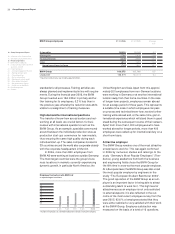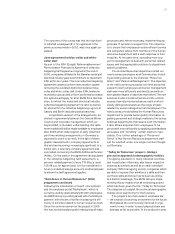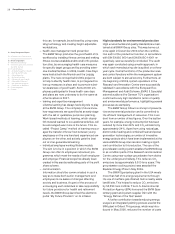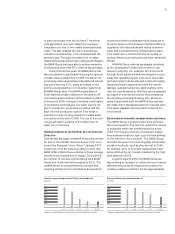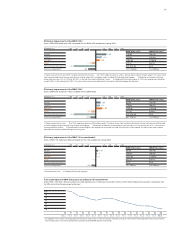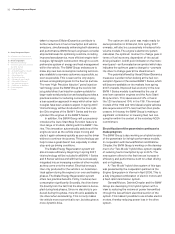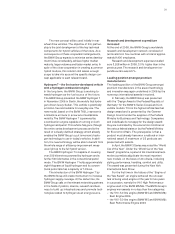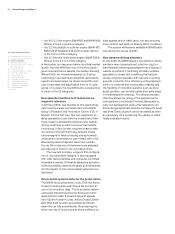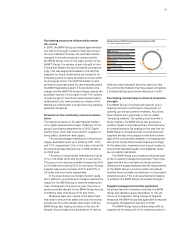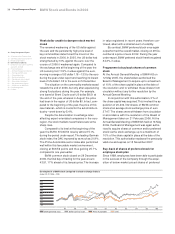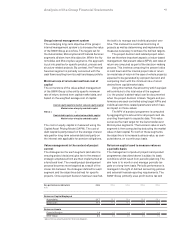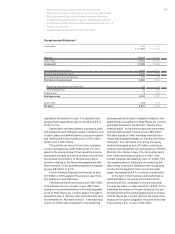BMW 2006 Annual Report Download - page 37
Download and view the complete annual report
Please find page 37 of the 2006 BMW annual report below. You can navigate through the pages in the report by either clicking on the pages listed below, or by using the keyword search tool below to find specific information within the annual report.36 Group Management Report
10 Group Management Report
10 A Review of the Financial Year
12
General EconomicEnvironment
15 Review of operations
38 BMW Stock and Bonds
41 Disclosures pursuant to §289 (4)
and §315 (4) HGB
43 Financial Analysis
43 – Internal Management System
44 – Earnings performance
46 – Financial position
48 – Net assets position
50 – Subsequent events report
50 – Value added statement
53 – Key performance figures
54 – Comments on BMW AG
58 Risk Management
62 Outlook
order to elucidate potential topics of innovation. The
technical and commercial feasibility of new ideas is
then jointly evaluated. The BMW Group also involves
its large system suppliers in the initial phase of the
development process for new products. At supplier
workshops, also held early on in the creative process,
joint solutions are worked on to reduce manufac-
turing costs and optimise technical issues, such as
vehicle weight reduction.
The growing complexity and inter-connectivity
of modern vehicles increases the responsibility of
suppliers within the supply chain. The BMW Group
encourages its suppliers to be aware of this respon-
sibility, particularly in the area of quality manage-
ment using web-based quality planning tools and
further training.
An electronic standard has been put in place to
monitor the core processes involved in working to-
gether with suppliers. Inquiries, purchase orders and
specific supply requests for series and test compo-
nents are sent electronically viaEDI (Electronic Data
Interchange) or the internet.The same channels can
also be used to obtain information on parts origin,
materials balance details regarding recycling require-
ments or change management information.
As part of the process of increasing the level of
responsibility that suppliers are expected to assume
for quality, the BMW Group also provides real-time
data to its suppliers. Data regarding supply quality
from all plants can be retrieved, as can information
concerning customer complaints and warranty costs.
High ecological and social standards expected
of suppliers
The BMW Group also expects its suppliers to ad-
here to high social and ecological standards. The
BMW Group’s national and international purchasing
guidelines also stipulate social and ecological stan-
dards.
Surveys are regularly made about how suppliers
comply with, and implement, those standards. This
data is recorded in the BMW Group’s supplier data-
base. In 2006, the BMW Group, together with its
suppliers, successfully implemented all current re-
quirements stipulated by the EU End-of-Life Vehicle
Directive with regard to prohibited materials.
Sales network expanded further
In 2006, the main challenge for the BMW Group
in terms of sales and marketing activities was the
strengthening of its global sales network.
The BMW Group continued to expand its
pres-
ence, especially in developing markets.The Group
also invested in its established markets by strength-
ening its sales organisation in these areas. Although
the Group’s highest growth rates were achieved
in emerging markets, the market triad of Western
Europe, the USA and Japan still generates around
85% of the BMW Group’s total sales volume.
In 2006, the BMW Group continued its prepara-
tions for entering the Indian market. The new sales
company in Delhi started operations on1 January
2007.The official opening of the new BMW Group
plant in the southern Indian city of Chennai is
planned for March.
The BMW Group also opened its own sales
organisations in the Czech Republic and Slovakia
with effect from 1 July 2006 and in Slovenia with
effect from 1 January 2007.This is all part of a Group
strategy to assume direct market responsibility in
all EU countries within Central and Eastern Europe.
At a dealership level too, the BMW Group pressed
ahead with its engagement in new markets.The
number of dealerships in China was increased to
61 in 2006, representing a rise of approximately
one third compared to one year earlier. The first
steps were also taken to create a dealership net-
work in India.
In the established markets, by contrast, activities
aimed at strengthening the quality of the existing
sales organisation dominated. Here too, the main
focus was on retail sales. In the final analysis, nine
out of ten BMW and MINI customers purchase their
vehicles at one of over 3,000 BMW or 1,500 MINI
dealerships around the world.
It is essential for the overall success of the
BMW Group that dealerships are given support in
the development of common business interests.
Measures taken in this respect in 2006 included
continued implementation of the Customer Relation-
ship Management Programme and the Used Vehi-
cle Programme as well as investments in training
centres for dealers, such as in the United Kingdom,


